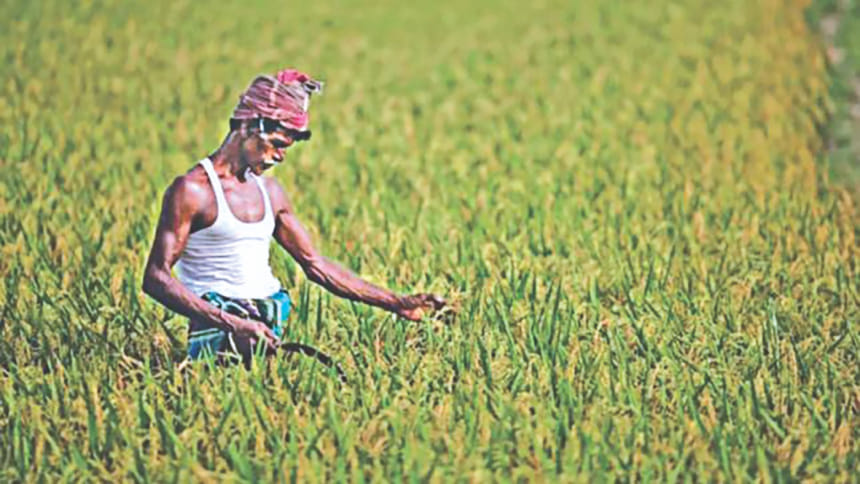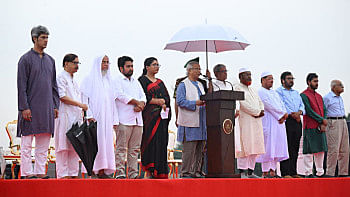Smart age shaping agriculture and food security

The thought process of people is evolving with the everyday progress in science and technology. As a result, everything around us is changing. The revolutionary development of people's lifestyle and consciousness has been far greater than the change of the past centuries. Similar to all other fields, the change in agriculture is much more noticeable, at least with my journalistic vision, since I have been involved with development journalism for the past four decades. I spend time with farmers. I consider their problems my own and present those through the media. That is how the stories of prospect and the less focused or neglected sectors of farming are spread to the broader mass. In this long time, I have witnessed the diversified farming sector transformed from the traditional. At this time of prosperity, we are witnessing the abundance of crops. Our success in producing rice, cereal, vegetables, fruits, fish, meat, eggs and milk is quite huge. However, farmers have achieved this success overcoming many adversities. Behind this lies the influence of the free-market economy and globalisation. Similarly, the individual initiatives of the farmers also played a vital role. Farmers have been able to achieve some commercial success on their own by cultivating high-value crops as well. On the other hand, the government's agriculture ministry has been conducting diverse activities to encourage crop diversity for further enriching the sector. In the post-liberation war period, these government activities had considerable momentum, however, at the beginning of the current century, all those efforts became lost motion. Over the past decade, these development initiatives again saw a lot of progress with speed.
According to the Annual Food Security and Nutrition report of Food and Agriculture Organization of the United Nations, published in November 2019, major cereal production in the country has increased three to five times during forty-eight years of our liberation. Bangladesh is among the top five countries in the world in producing twelve agricultural products. The report also states the number of people suffering from malnutrition in Bangladesh has also increased. Even the numbers for obese and stunted people have increased. Food production in the country has reached a level of firmness. Now in terms of agricultural production, the question of safe food and nutrition security remains at the forefront.
Over the past ten years the farmers have, at an alarming rate, moved away from the profession of farming. The family tradition of agriculture is breaking down in our country while various organisations, including the United Nations, are considering family farming to make the farming sector sustainable. The families accustomed to ancestral agrarian lifestyle are now stepping out from farming and the new generation is getting involved in either business or service sector.

One of the major reasons behind this is farming equipment and farm-labour cost. The production cost goes high and the profit margin becomes squeezed. They are either selling their farmlands or giving those on lease. Consequently, farm labourers have focused more on family farming after acquiring farmland rights. This segment of farmers is benefiting greatly by farming on their own.
Not to mention, another segment of farmers has emerged as a result of this change in the farming sector, commonly known as "the farm entrepreneur". This is the time of agricultural entrepreneurship. This newly emerged individual or group of people are building modern agricultural farms after procuring lands or taking long-term lease from the original landowners.New technologies are being added to their work strategy.
To meet the demands of modern farming, advanced methods for ensuring more production from small lands are being followed. On one hand, the vertical expansion is underway, on the other hand, cultivation in a controlled environment i.e. greenhouse is also taking place. The development of soilless farming has begun over time, in addition to modern technology. Many have become accustomed to agricultural practices such as aquaponics and hydroponics. The best practices have begun to be used essentially in agriculture. It is being called, "Good Agricultural Practices". Our country achieved amazing success in vegetable and fruit production. Some vegetables and fruits are being produced in greenhouses following the footsteps and best examples in Europe, USA and the Middle East. Moreover, imported quality seeds are the biggest contributor to getting higher yields.
As I said earlier, individual initiatives have contributed greatly to the diverse development of agriculture in the country. Various private companies and development organisations continue to play a significant part in enhancing farmers' awareness on local-foreign research, use of improved seeds and seedlings, training farmers and better market structure. It is necessary to mention that the media has been carrying out the responsibility of motivating them. Since I am a development journalist, the past and present image of the country's agriculture is as clear to me as daylight. I have seen exactly where our farmers are lagging; where their crisis lie. When a good practice, an advanced method or technology or the successful image of an entrepreneur is promoted on the media, it gets a lot of response. A good initiative spreads from one person to another. A good technology spreads from one farmer to the other. Efforts were made to get farmers out of their traditional concept of farming back in the 80s, as well as to awaken the zealous spirit of a farmer, homemaker or a professional through spirited promotion on media by me. Even though it started with a slow response initially, later it started to achieve diverse success. Needless to say, first Bangladesh Television's "Mati O Manush" (Soil & People) and later Channel i's "Hridoye Mati O Manush" (Soil & People in Heart) have been successfully playing an extraordinary role in shaping the dream of a developed, diversified, ever-evolving farming sector, leading farmers beyond the production of rice and jute to many different crops, vegetables. It also included fish farming, setting up dairy farms, biogas plants and commercial poultry farms, replacing the domestic ones. Thus, media now stands tall among the regulators of development behind the farming sector of Bangladesh.
Farmers have become more enthusiastic about meeting the demands of the present time. They did not sit idle waiting for someone else. They broke out of their traditional boundaries and concepts. They ran from district to district after watching the best agricultural practices in the media. Overcoming versatile diversities, they used to dream of having crop diversity. However, since they could not avail any local or national support in this regard, they were bound to lean on the seeds and seedlings brought from a neighbouring or foreign country by an entrepreneur.
They have achieved magnificent success in farming. Seed companies started taking initiatives witnessing the farmers' commercial success and interest. The companies have chalked out commercial plans considering the needs of the farmers. Similarly, a local market of pesticides, fertilisers and integrated pest management supply has also emerged. Altogether, a great commercial sphere now belts around the agriculture sector. Therefore, even though the contribution of agriculture to the country's GDP has lowered down to 14 percent, yet its overall contribution to the economy remains high.
Agriculture has now become a more investment-oriented commercial enterprise. New information technology is bringing more profit and productivity. The progress of Bangladesh in the development of agro-technology in line with the developed world is astounding. The scenario of the past decade shows that the entrepreneurial farmers of Bangladesh followed the agricultural practices we showcased on the media; all best examples from developed countries of the world caught the attention of many entrepreneurs. Notably, the fourth industrial revolution has begun to make its mark on our country's agriculture sector.

In the history of human civilisation, three industrial revolutions have changed the course of the entire world. The First Industrial Revolution occurred through the invention of the steam engine in 1784. After that, the discovery of electricity in 1870 and the internet in 1969 accelerated the pace of the industrial revolution by a mile. However, the digital revolution of the present time may overtake the previous three revolutions. It is creating a stir in the entire world. This is now being called the Fourth Industrial Revolution. Experts say that our lifestyle, activities and thoughts have started to change. Now we are going through a technological change. The digital revolution, which began based on the second and third industrial revolution, is changing everything at a mathematical rate like never before. Most importantly, this change is impacting every sector of every country in the world, thereby changing the production process, management and everything else. Smartphones changing the information technology sector around the world, the Internet of Things, the application of artificial intelligence to operate machines, robotics, biotechnology, quantum computing etc. have paved the path to the Fourth Industrial Revolution.
Artificial intelligence and the Internet of Things are now being added to the new agriculture machines. Every year we visit one of the world's largest agricultural machinery exhibitions in China. Over there I observe the world's most modern agricultural machinery. I see robotics technology also being incorporated in most agricultural machines. The idea is to reduce human labour in the production sector. At the same time, modern information technology is being used effectively to facilitate production efficiency, development capacity and the marketing system. The biggest success of agricultural mechanisation in Bangladesh has been witnessed in land cultivation. Now ploughing has a 95 percent usage on land farming. Similarly, thresher and power pump have 95 percent usage in rice threshing and irrigation respectively. Other areas of agriculture are experiencing mechanisation slowly. For instance, there is only 1.5 percent mechanisation in harvesting and less than 0.5 percent in planting. However, the use of agricultural machines is increasing day by day. This has led to a significant increase in crop production. Similarly, agro-machine manufacturing companies of our country are continuing their efforts to integrate IoT and artificial intelligence with their products. According to a recent study on agricultural mechanisation in SAARC countries, local manufacturers in Bangladesh are meeting the demand of 20 percent of agricultural machinery apart from imports. There are 70 foundries, 2 thousand agricultural machine and tool manufacturing factories and 20 thousand machinery repair factories. Local companies are meeting the demand of 60 percent of agricultural machine parts. The present government has placed considerable emphasis on agricultural mechanisation. About 50 percent subsidy is available for all farmers to purchase agricultural machinery. Besides, 70 percent subsidy is available for Haor farmers to purchase some certain agricultural machines. Apart from this, the government has also allocated 3 thousand crore Taka (350 million US Dollars) out of the total 9 thousand crore Taka subsidy for the agriculture sector to buy agro-machines.

Recently, various initiatives have been undertaken in the country to pursue unadulterated agricultural production with the help of various international donor organisations. The Netherlands-based development organisation, Solidaridad, along with several other non-government organisations, including the DAE (Department of Agricultural Extension), have established pesticide-free vegetable crop production and middlemen-free market structure in several districts of the country. In the south, they have set up a village supermarket with multipurpose facilities. The farmer is selling his product at a specific sales centre in his village.
From there, the products are transported to the village supermarket through developed management services. There, initiatives are being taken to clean, sort and package agricultural products in a very standard manner and afterwards those are sent to different markets in the capital. Already vegetables have been marketed in this process. An important aspect of this initiative is to ensure safe crop production and supply chain. In this same process, purity has been maintained in fish, meat and milk production and a precise market system has also been established. Through this, farmers have come under the practice of producing safe crops.
In recent times, a new interest in using modern technology is observed among farmers. Developed countries are incorporating smart technology to agriculture. The use of this smart technology has also started in Bangladesh. The use of IoT has now begun in dairy and livestock farms of the country. Meanwhile, with the help of Grameenphone, Digi Cow and Shurjomukhi Pranisheba have begun to provide IoT services to livestock farms. The last year has been quite successful with the use of digital and smart technology. Entrepreneurs are much more motivated and optimistic about using digital technology. Dutch Dairy Ltd is a smart dairy farm with ultramodern technology based at Satgharia in Munshiganj's Louhajang, established a year and a half ago where digital and smart technologies are being implemented successfully. It is expected that within a few years, our country will start using digital technology in dairy and meat production. This will ensure the complete purity of milk or meat while increasing production.
There has been a breakthrough innovation in our fisheries sector as well. It is a technique for controlling ammonia in fish farming ponds and providing sufficient fish feed. Shafiul Alam and Tania, two software engineers in Bangladesh, have developed "Smart aerator and feeding device" as the result of their long research. The machine won the best prize at an international innovation competition held in Seoul, South Korea. They are hopeful that when this device will be fully integrated into our country's fishery sector, it will be the start of a great revolution in fish production.
Diverse success has been achieved in terms of ensuring nutritional security in the country. We are having great success in the fisheries sector. Thanks to young entrepreneurs and farmers of the country. Modern technology "Recirculated Aquaculture System (RAS)" and "Biofloc" have also been introduced in fish farming just like Vertical Expansion and Soilless Farming methods. In addition to these two methods, controlling the level of ammonia in the water and reducing the cost of cultivation has yielded a huge response among young entrepreneurs in producing a large amount of fish in a small place. Many educated conscious entrepreneurs of Bangladesh have been involved in this farming method and have been trying to lead us further ahead than the current third position we hold in the world for freshwater fish production. They hope that Bangladesh will soon reach the top spot for fish production in the world. At the same time, a huge export success will also be witnessed in this sector in the near future.
Agriculture is suffering from the versatile impact of climate change. Not only Bangladesh but the entire world is dealing with the negative effects of climate change. In the worldwide agricultural studies, this issue is quite seriously observed. Hostile climate tolerant crop variety and agriculture method are being invented. New technologies are coming up. Countries like ours need to strengthen its research in this aspect. Along with that, there is a need to motivate and accustom the farmers to the best practices of agriculture at all levels. In this case, modern technologies such as IoT and artificial intelligence are very important. Even after having increasing productivity and diverse success in agricultural commercialisation in the era of the Fourth Industrial Revolution, a major challenge remains in the sector, which is favourable market structure for the farmers. Due to this, the farmers are still not getting the fair price for their produce, despite the increase in crop varieties and production. Just like farmers do not have the right to set the price of their products, similarly, the government has no right to set up a price commission for the producer. This is a never-ending crisis of farmers. Till date, no effective or sustainable initiative has been taken to resolve this. In the prevailing market system, the farmers get some price at the beginning of every harvest season, but eventually, they face loss. Farmers in some areas may cover the loss by growing four crops in a year. But small and marginal farmers in most areas do not benefit enough. In the current era of smart technology, no platform has been developed to provide a viable solution to a favourable market structure for the farmer. For the first time in the country, through using the mobile application under government management, Aman rice was collected from selected farmers. But it did not succeed in most cases. Farmers had complaints about the process. They also complained regarding the timing of the rice collection project. They say the government started the campaign after the farmers had to sell their rice at a low price when a new shipment of rice was coming to the market. Thus, the farmers did not get the opportunity to sell rice during the government rice collection campaign. Another problem is the government's tendency to allow imports from abroad during the full season of local fruits and crops. Year after year, from onion, ginger, garlic to high-value fruit guava, almost all agro-products are facing unequal market competition. This should be the greater concern of the government. It is heard that the Ministry of Agriculture has taken initiatives on the policy level to take effective action in this regard, given the farmers' complaints and the media efforts to bring forth these issues. If the challenge of the market is tackled, the success of today's agriculture will reach a more exemplary height. At the same time, if the government is more passionate in producing safe and chemical-free crops, we would be able to achieve both the food and nutrition security we desire so very much.
Shykh Seraj is a multi-award-winning journalist, and recipient of Bangladesh's two highest civilian honours, Swadhinata Puroshkar and Ekushey Padak.

 For all latest news, follow The Daily Star's Google News channel.
For all latest news, follow The Daily Star's Google News channel. 



Comments